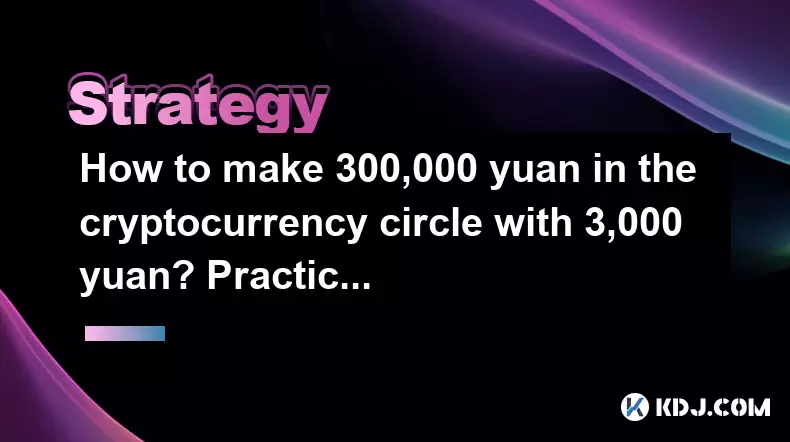-
 bitcoin
bitcoin $112195.049338 USD
2.42% -
 ethereum
ethereum $4124.915858 USD
2.81% -
 tether
tether $1.000570 USD
0.02% -
 xrp
xrp $2.861568 USD
2.25% -
 bnb
bnb $1000.346670 USD
3.04% -
 solana
solana $209.070819 USD
3.38% -
 usd-coin
usd-coin $0.999870 USD
0.02% -
 dogecoin
dogecoin $0.235379 USD
2.65% -
 tron
tron $0.335681 USD
-0.20% -
 cardano
cardano $0.803501 USD
3.38% -
 hyperliquid
hyperliquid $47.120881 USD
3.56% -
 chainlink
chainlink $21.501300 USD
3.44% -
 ethena-usde
ethena-usde $1.000571 USD
0.02% -
 avalanche
avalanche $29.793378 USD
3.62% -
 stellar
stellar $0.366964 USD
2.42%
How to make 300,000 yuan in the cryptocurrency circle with 3,000 yuan? Practical analysis of trend trading
Trend trading in crypto can turn 3,000 yuan into 300,000 yuan with patience, discipline, and effective risk management, focusing on high-liquidity assets like Bitcoin and Ethereum.
Jun 12, 2025 at 10:35 am

The cryptocurrency market presents a unique opportunity for individuals to grow their investments significantly, even starting with a modest sum like 3,000 yuan. This article will explore how one might aim to reach 300,000 yuan through trend trading, a strategy that involves capitalizing on market trends. Understanding and executing trend trading effectively is crucial, as it requires patience, discipline, and a solid grasp of market dynamics.
Understanding Trend Trading
Trend trading is a strategy where traders buy and sell assets based on the identification of market trends. The goal is to enter a trade during the early stages of a trend and exit it before the trend reverses. In the cryptocurrency market, trends can be influenced by various factors, including technological developments, regulatory news, and broader market sentiment.
To successfully engage in trend trading, one must first learn to identify trends. This involves analyzing price charts to spot patterns such as uptrends, downtrends, and sideways movements. Technical analysis tools like moving averages, trend lines, and the Relative Strength Index (RSI) are essential for this purpose. By using these tools, traders can make informed decisions about when to enter and exit trades.
Setting Realistic Goals and Risk Management
Starting with 3,000 yuan and aiming for 300,000 yuan requires setting realistic goals and implementing stringent risk management strategies. The potential for high returns in the cryptocurrency market is accompanied by significant risks. Therefore, it's crucial to define your risk tolerance and set stop-loss orders to protect your investment.
For instance, if you decide to allocate your 3,000 yuan across several trades, consider using a risk-reward ratio that aligns with your goals. A common approach is to aim for a 1:3 risk-reward ratio, where you risk 1 yuan to make 3 yuan. This means that even if some trades fail, successful trades can cover the losses and still contribute to your overall goal.
Selecting the Right Cryptocurrencies
Not all cryptocurrencies are suitable for trend trading. It's essential to focus on assets with high liquidity and volatility, as these characteristics can lead to more pronounced trends. Bitcoin and Ethereum are typically good candidates due to their market dominance and the volume of trading activity they attract.
Researching the fundamentals of the cryptocurrencies you're interested in can also provide insights into potential trends. For example, if a major technological upgrade is on the horizon for a particular cryptocurrency, it might trigger an uptrend. Keeping abreast of news and developments in the crypto space can help you make informed decisions about which assets to trade.
Implementing a Trading Plan
A well-thought-out trading plan is vital for achieving your financial goals in the cryptocurrency market. Your plan should outline your entry and exit strategies, the amount of capital you're willing to risk per trade, and the timeframe over which you aim to achieve your target. For instance, if your goal is to reach 300,000 yuan within a year, your plan should detail how you intend to grow your initial 3,000 yuan through a series of successful trades.
Here's an example of how you might structure your trading plan:
- Identify potential trends using technical analysis tools.
- Enter trades when you confirm the start of a trend.
- Set stop-loss orders to manage risk.
- Monitor the market and adjust your positions as needed.
- Exit trades when the trend shows signs of reversal.
Executing Trades
Once you have identified a trend and decided to enter a trade, executing the trade efficiently is crucial. This involves placing your order at the right time and ensuring that your stop-loss and take-profit levels are set according to your trading plan.
For example, if you notice an uptrend in Bitcoin, you might decide to buy when the price breaks above a key resistance level. Here are the steps to execute this trade:
- Open your trading platform and navigate to the Bitcoin trading pair.
- Place a buy order at the current market price or set a limit order just above the resistance level.
- Set a stop-loss order below the recent swing low to protect your investment.
- Set a take-profit order at a level that aligns with your risk-reward ratio.
Monitoring and Adjusting Your Strategy
The cryptocurrency market is highly dynamic, and trends can change rapidly. Regularly monitoring your trades and the broader market is essential for success. If a trend you're following begins to weaken, it may be time to exit your position and reassess your strategy.
Additionally, keeping a trading journal can help you track your performance and learn from your successes and failures. Documenting each trade, including the entry and exit points, the rationale behind your decisions, and the outcome, can provide valuable insights into your trading style and areas for improvement.
Frequently Asked Questions
Q: How long does it typically take to turn 3,000 yuan into 300,000 yuan through trend trading in the cryptocurrency market?A: The time it takes to achieve such a significant return can vary widely depending on market conditions, the effectiveness of your trading strategy, and your risk management practices. Some traders might achieve this goal in a few months, while others might take longer or not reach it at all.
Q: Is it necessary to use leverage to achieve high returns in trend trading?A: While leverage can amplify returns, it also increases risk. It's possible to achieve significant returns without leverage by focusing on high-quality trades and managing risk effectively. However, if you choose to use leverage, do so cautiously and understand the potential for amplified losses.
Q: Can trend trading be automated using trading bots?A: Yes, trading bots can be programmed to execute trend trading strategies. However, it's important to thoroughly test any bot and monitor its performance, as the cryptocurrency market's volatility can lead to unexpected outcomes.
Q: What are some common pitfalls to avoid in trend trading?A: Common pitfalls include overtrading, failing to set stop-loss orders, chasing trends that have already matured, and letting emotions drive trading decisions. Staying disciplined and sticking to a well-defined trading plan can help you avoid these mistakes.
Disclaimer:info@kdj.com
The information provided is not trading advice. kdj.com does not assume any responsibility for any investments made based on the information provided in this article. Cryptocurrencies are highly volatile and it is highly recommended that you invest with caution after thorough research!
If you believe that the content used on this website infringes your copyright, please contact us immediately (info@kdj.com) and we will delete it promptly.
- PM Modi, RSS Centenary, and a Postage Stamp: A Curious Intersection
- 2025-09-29 18:45:12
- Ethereum ETF, Bitcoin ETF, and Investor Nerves: A New York Minute on Crypto
- 2025-09-29 18:25:14
- Ripple, Ondo Finance, and Tokenized Treasuries: A New Era for Institutional DeFi
- 2025-09-29 19:05:13
- Navigating the Crypto Seas: Federal Reserve, Bitcoin, and Interest Rate Tides
- 2025-09-29 18:25:14
- RSS Centenary: A Commemorative Coin and a Century of Impact
- 2025-09-29 18:45:12
- Avantis Crypto Price Crash Amidst Soaring Perpetual Volume: What's Going On?
- 2025-09-29 18:30:01
Related knowledge

Practical parameter settings for a Bitcoin multi-timeframe moving average system
Sep 18,2025 at 10:54pm
Optimizing Timeframe Combinations for Bitcoin Trading1. Selecting appropriate timeframes is crucial when building a multi-timeframe moving average sys...

How can I filter out false breakouts in Dogecoin high-frequency trading?
Sep 22,2025 at 01:00am
Understanding False Breakouts in Dogecoin Trading1. A false breakout occurs when Dogecoin's price appears to move beyond a defined support or resistan...

Techniques for identifying tops and bottoms in the Bitcoin on-chain NVT model
Sep 20,2025 at 07:54pm
Understanding the NVT Model in Bitcoin Analysis1. The Network Value to Transactions (NVT) ratio is often described as the 'P/E ratio' of the cryptocur...

What does the surge in open interest in Bitcoincoin futures mean?
Sep 20,2025 at 11:18pm
Understanding the Surge in Dogecoin Futures Open Interest1. A surge in open interest within Dogecoin futures indicates a growing number of active cont...

How can I use the Ethereum USDT premium to gauge market sentiment?
Sep 18,2025 at 11:55pm
Understanding the Ethereum USDT Premium1. The Ethereum USDT premium refers to the price difference between USDT (Tether) traded on Ethereum-based plat...

What should I do if Ethereum staking yields decline?
Sep 20,2025 at 06:18am
Understanding the Causes Behind Declining Ethereum Staking Yields1. The Ethereum network transitioned to a proof-of-stake consensus mechanism with the...

Practical parameter settings for a Bitcoin multi-timeframe moving average system
Sep 18,2025 at 10:54pm
Optimizing Timeframe Combinations for Bitcoin Trading1. Selecting appropriate timeframes is crucial when building a multi-timeframe moving average sys...

How can I filter out false breakouts in Dogecoin high-frequency trading?
Sep 22,2025 at 01:00am
Understanding False Breakouts in Dogecoin Trading1. A false breakout occurs when Dogecoin's price appears to move beyond a defined support or resistan...

Techniques for identifying tops and bottoms in the Bitcoin on-chain NVT model
Sep 20,2025 at 07:54pm
Understanding the NVT Model in Bitcoin Analysis1. The Network Value to Transactions (NVT) ratio is often described as the 'P/E ratio' of the cryptocur...

What does the surge in open interest in Bitcoincoin futures mean?
Sep 20,2025 at 11:18pm
Understanding the Surge in Dogecoin Futures Open Interest1. A surge in open interest within Dogecoin futures indicates a growing number of active cont...

How can I use the Ethereum USDT premium to gauge market sentiment?
Sep 18,2025 at 11:55pm
Understanding the Ethereum USDT Premium1. The Ethereum USDT premium refers to the price difference between USDT (Tether) traded on Ethereum-based plat...

What should I do if Ethereum staking yields decline?
Sep 20,2025 at 06:18am
Understanding the Causes Behind Declining Ethereum Staking Yields1. The Ethereum network transitioned to a proof-of-stake consensus mechanism with the...
See all articles










































































